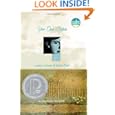Hemphill, Stephanie. 2007. Your Own, Sylvia. New York: Alfred A. Knopf. ISBN: 978-0-375-83799-9.
Your Own, Sylvia tells the story of Sylvia Plath, a tormented young poet who took her own life fifty years ago. Hemphill tells Plath’s story from birth to suicide through poems, each from the point of view of someone in Plath’s wife. Although the book is a work of fiction, Hemphill researched Plath’s life through journals, poems, interviews, and biographies. The poems reflect the feelings and thoughts of those who loved Plath. The poems are told in chronological order, and each poem is accompanied by information about Plath’s life and work at the time of the event.
What stands out about this work is its haunting picture of a woman who had “everything” yet nothing. Plath’s intelligence, social life, family support, and even her children could never help her overcome her own demons inside. Even with her success, she still found herself searching. Perhaps it was mental illness or anguish over her father’s death. Since her last journal and many letters were destroyed, the public may never know why she took her own life. The poems reflect the ups and downs of a woman who did not quite know herself or what she was doing. The emotion of the poems carries the tale and implores the reader to check out the original work of Sylvia Plath.
While the book should be read in its entirety to get full story of Plath’s life, several poems can be taken out of the book for individual analysis. These poems, written by Hemphill, were imitations of Plath’s own poems. Underneath the title of these poems, Hemphill indicates which of Plath’s poems is mimicked.
“Paris in the Winter”
Imagining Sylvia Plath
In the style of “Winter Landscape, with Rooks”
Winter 1956
"She repeats his name like a lullaby,
the sonorous Sassoon. He sings
To her, then flaps his wings, a magpie
shaking his tail of her. Nothing
For her between his beak except lies.
She sketched this out in faded watercolor,
Richard not answering
Her bell, fleeing her like a schoolboy. Where
did he run? She circles his building.
She taps her cold toes. Did he even open her letter?
She freezes this trip to Paris, the city of pigeons.
There are not enough scarves to warm her.
She stalks his door. She awaits his return
ridiculous as a rook without its jacket of feathers.
She never once glimpses his silhouette against the curtain."
This poem can be read by an English class to compare to Plath’s work, analyzing the similarities in style and emotion.


No comments:
Post a Comment